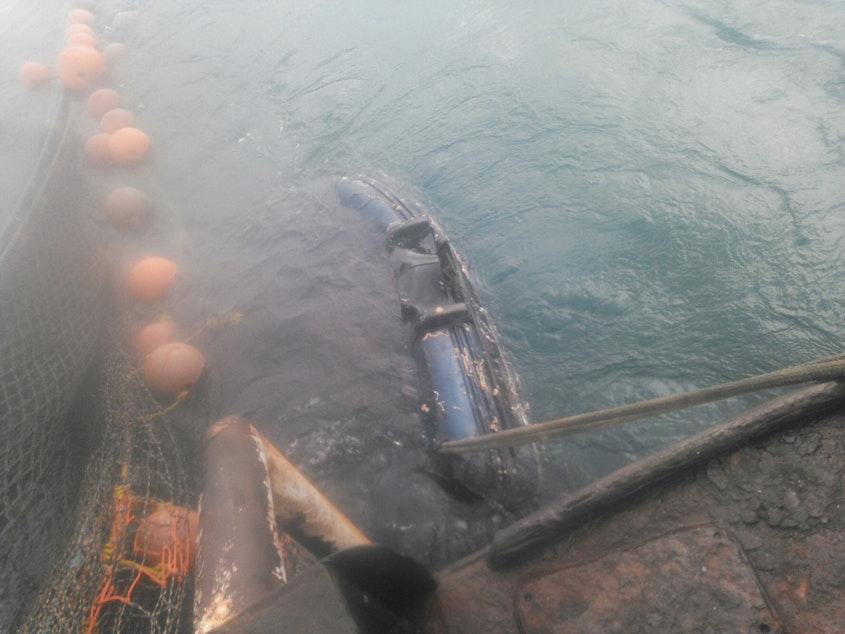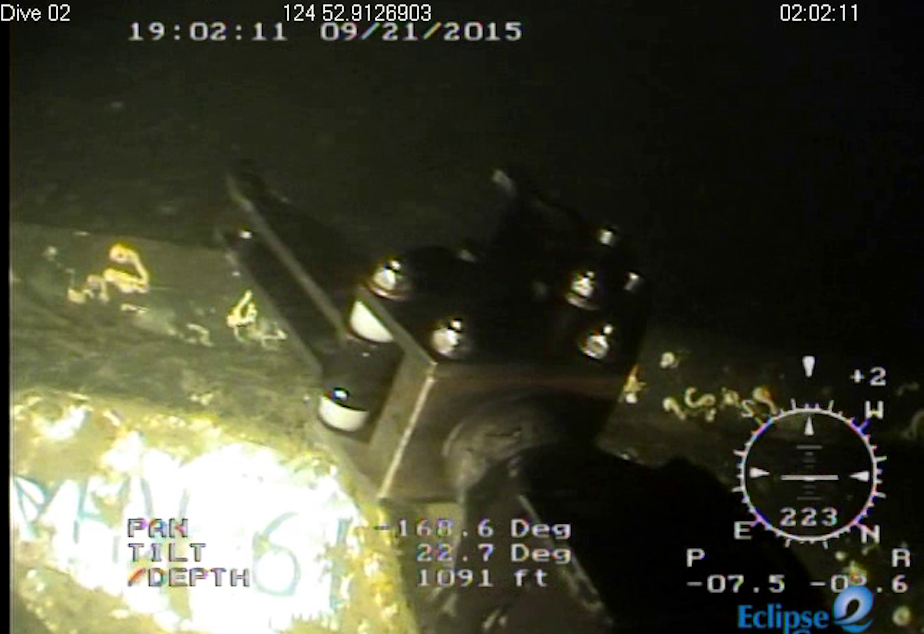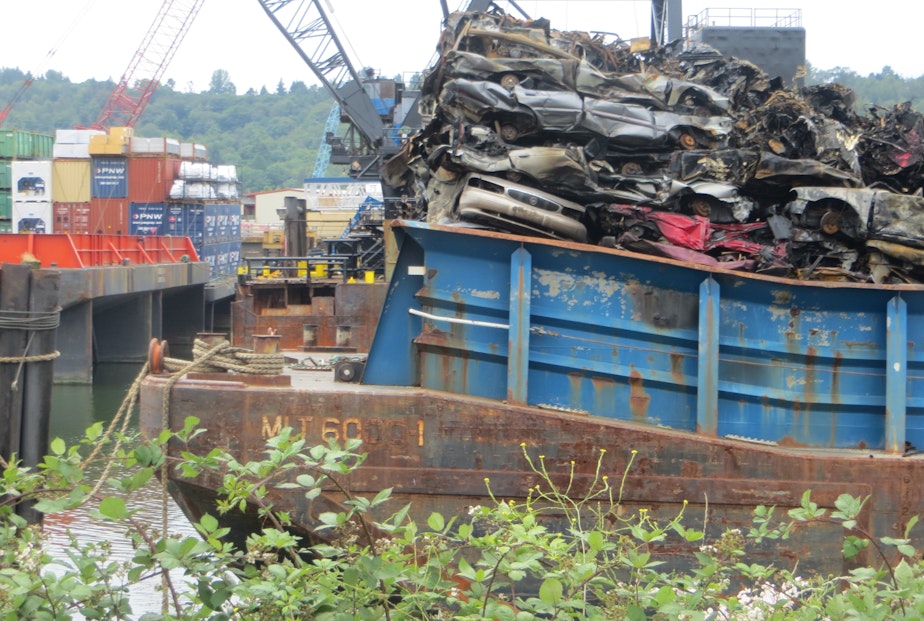Sedan overboard! How the bottom of the Pacific got littered with junk cars

Miles off the Washington coast, the sea floor is alive with anemones, sponges and even deepwater corals. Rockfishes older than any human hover near crevices and caves.
Also dotting the sea floor is something you wouldn’t expect in this remote and watery wilderness: crushed cars, with Canadian bumper stickers and license plates.
How in the world did they get there?
Out where the water is a thousand feet deep, an old wooden fishing boat was slowly dragging its net along the sea bed. It was trawling for Dover sole, flatfish about the size of dinner plates.
“There's only a couple of spots in the area that are that deep, and we have lots of really giant Dover within there,” said Makah tribal fisherman Larry Buzzell of Neah Bay, Washington, on his way back from a more recent fishing trip.
“Right now I'm about, let's see here, we're four miles southwest of Tatoosh Island, on our way in," Buzzell said by cell phone from his daughter’s fishing boat.
Three years earlier, not far from that same spot off the Olympic coast, Buzzell was out on his own boat, a 60-foot schooner built in 1924. He said it’s a beautiful old boat, “especially when it’s painted.”
They were putt-putting over a smooth, muddy patch of seafloor — good for trawling without damaging either the bottom habitat or the heavy net moving over it — when, suddenly, the boat stopped.
“The first thing goes through your mind is, ‘Dammit!’ because you've invested a lot of time and energy to get that net out there in that deep water, and now it's all wasted because once the net stops, the fish swim right out,” Buzzell said.
His crew had to reel the net back in to figure out what had gone wrong far below.

 19 secs
A remote-controlled submarine arm grabs the “Beautiful British Columbia” license plate off a scrap car 1,091 feet below the surface off the Washington coast in 2015.
19 secs
A remote-controlled submarine arm grabs the “Beautiful British Columbia” license plate off a scrap car 1,091 feet below the surface off the Washington coast in 2015.
“We figured we might have a boulder, who knows why,” Buzzell said. “We're dragging along this very particular route where there's no rocks, no reefs, no anything.”
“But as we pulled the net up, we saw a fender and a license plate and a crushed car, stuck in the mouth of the net,” he said.

“Imagine a whole, entire car hanging off the back of your boat. What are you going do?” he asked. “Especially if it's twisted up and tangled up in a net. Somehow you have to get that out of there and get the net off of it."
“Or else you've lost $25,000 to $30,000 worth of equipment.”
Fishing remains exceptionally important to the Makah tribe, whose per-person income is $17,000, just above half the national average.
In exchange for giving up most of their land to the U.S. government in 1855, the Makah and other tribes retained treaty rights to fish in their “usual and accustomed” areas.
Buzzell said the Makah tribe only has a couple of smooth, deep spots where they can drag bottom trawls without damaging either their nets or sensitive habitats like rocky reefs.
Sponsored
With a knife, some rope and some mid-sea maneuvering and MacGyvering, the crew managed to untangle the car from their net. Then they motored over to a less valuable fishing spot and cut it loose, back to the bottom.
Buzzell and his crew were able to repair their damaged net and resume fishing.
Just what was a flattened car doing down there anyway? Turns out, it wasn’t the only one.
Sponsored

Sonar scans of the area have showed about a dozen cars on the seabed of the Olympic Coast National Marine Sanctuary, the little-known but very large protected area off Washington’s west coast.
More than twice the size of Olympic National Park, it has a staff of 11.
Commercial fishing and cargo shipping are allowed in the sanctuary. Dumping cars is not.
“We've been able to pull up license plates and track it back to some person in Toronto, who sold it to a junk dealer, and it ended up in Vancouver, and a barge took it down,” said Bill Douros with the National Oceanographic and Atmospheric Administration. He’s in charge of marine sanctuaries on the West Coast.
“Lo and behold, it looks like a few of them fell off,” Douros said.
Flattened scrap cars have been tumbling off barges on their way from Vancouver, B.C., to Portland since at least 2011.
“Multiple times — and they just put these cars on as high and as thick and as dense as they can. They tow them through the sanctuary, and they fall out,” he said.
Douros called the car pollution “very frustrating” for the sanctuary.
“The lawyers have educated me that there's not much we can do about it,” he said.
The Coast Guard started to investigate the problem last fall. They called the investigation "Operation Jalopy."
“It's unacceptable to have cars dumped in our waters,” Coast Guard Lt. Cmdr. Xochitl Castaneda said.
Sponsored
Shippers are required to tell the Coast Guard any time they lose cargo or spill something at sea.
But picture one of these barges: about the size of a football field, with thousands of cars stacked 10 or more high. It plows through the sea hundreds of feet behind the tug it’s tethered to and the crew working there.
“The likelihood is that they didn't even notice it, and they continued to transit,” Castaneda said.
Castaneda said the Coast Guard contacted Canadian and U.S. companies involved in the scrap-car trade here. But they couldn’t trace the fallen cars to a specific firm.
“The Coast Guard can't prove who lost this cargo,” she said.
So they started doing surveillance.
“We have helicopters. And as they were doing their routine patrols, then they would take pictures of those vessels as they were transiting the waterways,” Castaneda said.
Castaneda said the overflights showed the scrap haulers had improved their loading techniques by leaving extra room around the edge of the barges. If a car tumbled off the top of the scrap pyramid, it shouldn’t fall overboard.
She declined to name the companies involved and said they were receptive to working with the Coast Guard. KUOW has filed a Freedom of Information Act request to get the names.
But one of the companies the Coast Guard investigated is Portland-based Schnitzer Steel. Its barges have spilled cars in Tacoma and Victoria in recent years.
“This type of trade has demonstrated itself to be not particularly reliable,” Olympic Coast National Marine Sanctuary deputy superintendent George Galasso said. “We believe it’s entirely possible that additional cargo has been lost.”
In an email, Schnitzer Steel spokesperson Colin Kelly said the company "has always had a very robust barge loading policy and procedure."
“Based on the conversation with the Coast Guard, we did retain [an] international expert to review and update our plans. All parties that are involved in our barge shipments are required to follow our procedures,” Kelly said.
Robust procedures or no, barges hauling Canadian scrap for recycling have had multiple accidents in Washington state or neighboring waters over the past decade:
- A Portland-bound barge owned by Canadian firm Amix capsized and shed 4,500 tons of scrap metal into the sea near the mouth of the Columbia River in 2010. The Coast Guard then banned it from entering the river or the Olympic Coast National Marine Sanctuary. The barge was towed, upside down, back to British Columbia.
- Another barge owned by Amix (which became a Schnitzer Steel subsidiary in late 2010) took on water while headed for Schnitzer’s recycling plant in Tacoma in 2013. The listing barge dumped an unknown number of crushed cars into Tacoma’s Commencement Bay.
- A Seaspan barge listed and ended up dumping an estimated 100 scrap cars into a protected inlet at a Schnitzer recycling yard in Victoria, B.C., in 2015.
- A massive blaze erupted on a Schnitzer barge of scrap cars at Schnitzer’s dock in Victoria in 2017.
- A barge owned by Vancouver, B.C.-based Mercury Launch & Tug and filled with scrap cars owned by ABC Recycling of West Vancouver caught fire in Seattle’s Duwamish Waterway in 2018. Flaming cars spilled into the Duwamish.

Back out on the open Pacific, fisherman Larry Buzzell said his cousin caught a car in his net as well. The sprinkling of cars inside one of the Makah tribe’s best fishing areas means they can’t fish there any more.
“We had to give up. We have to wait for them to rust away, I guess,” he said.
Buzzell would like to see the cars removed.
“If we can catch them with our net, they can catch them with a grappling hook,” he said. “A couple of days out there, grappling back and forth, and you'll pretty much catch whatever's down there.”
Batteries and hazardous fluids are removed from vehicles before they are scrapped, according to the Coast Guard.
That’s not always true. The 2018 barge fire on the Duwamish began when a crane claw punctured a propane tank on a scrapped pickup truck.
Ocean-unfriendly plastic and foam could remain on scrapped cars as well.
But with no known hazardous materials left on the Northwest's deepest cars, there are no plans to haul them up.




